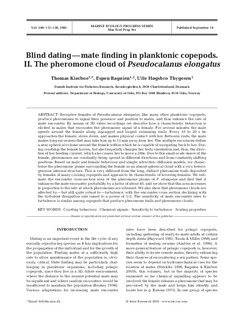| dc.description.abstract | Receptive females of Pseudocalanus elongatus, like many other planktonic copepods, produce pheromones to signal their presence and position to males, and thus enhance the rate of mate encounter. By means of 3D video recordings we describe how a characteristic behaviour is elicited in males that encounter the pheromone signal of a female. For several minutes the male speeds around the female along zigzagged and looped swimming trails. Every 10 to 20 s he approaches the female, slows down, and makes physical contact with her. Between visits, the male makes long excursions that may take him up to 15 mm away from her. The multiple excursions define a near-spherical volume around the female within which he is capable of navigating back to her. During courtship the female hovers, but she frequently changes her body orientation and, thus, the direction of her feeding current, which also causes her to move a little. Due to this small-scale dance of the female, pheromones are constantly being spread in different directions and from constantly shifting positions. Based on male and female behaviour and simple advection–diffusion models, we characterise the pheromone plume surrounding the female as an almost spherical cloud with a very heterogeneous internal structure. This is very different from the long, distinct pheromone trails deposited by females of many cruising copepods and appears to be characteristic of hovering females. We estimate the encounter cross-section area of the pheromone plume of P. elongatus and find that it enhances the mate encounter probability by a factor of about 40, and we show that this area increases in proportion to the rate at which pheromones are released. We also show that pheromone clouds are affected by—but still quite robust to—turbulence, with the encounter cross section declining with the turbulent dissipation rate raised to a power of 1/2. The sensitivity of mate encounter rates to turbulence is similar among copepods that produce pheromone trails and pheromone clouds. | no_NO |
